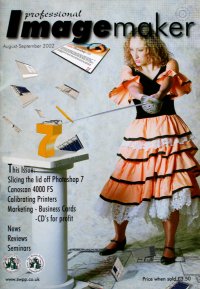articles/Review/canoscanfs4000us-page5
Canoscan FS 4000 US - part 5 of 1 2 3 4 5 6
by Mike McNamee Published 01/08/2002
Positive transparencies
We first scanned an IT8 colour target. This was done both with and without the Color Matching turned on. Using the Color Matching produced a better IT8 target with more neutral greys to the surround. The plot of the extreme values of the gamut shows how Color Matching has pushed the high saturation colours to the edge of the RGB gamut. This might not be to all tastes under all circumstances but the choice may be made to ignore the Color Match. Certainly for some film stock we preferred the scan without the assistance of Colour Match. The Color Adjustment palettes are greyed out when Color Match is on. Once we had elected to scan without Color Match we saved a set of corrections which we then applied all scans from that batch.
Colour negatives
These are a good test for a scanner. The FS 4000 "reads" the orange mask in the inter-frame margin and subtracts it from the scan. It works remarkably well and could be left to do its work unaided for most of the time. We did present the scanner with a badly processed negative (which had been ruined by the processing lab). The FS 4000 made a pretty good job of it and it only required a couple of mouse clicks to produce a very acceptable scan. By comparison this negative set cause endless hours of agony when we tried to scan it on a dual plate flat bed scanner some time ago.
When scanning at 4000ppi the grain of the negative was visible from the 400ASA negative films we scanned. This suggests that scanning at 4000 ppi is too much for this type of stock, you may as well stay at 2000 or 3000ppi and save some file size.
Monochrome Negatives
Monochrome negatives with their infinitely variable mix of exposure, developer, development and film type represent a bit of a challenge to any scanner. The FS 4000 had no problems and apart from a few minor tweaks in the exposure curve, we obtained good results effortlessly.
FARE (see below) does not operate on monochrome materials, you have to do your own clean-ups if they are required.
We also scanned a calibrated density target in monochrome and obtained differentiation right down to a transmission density of 2.95. The dynamic range of this scanner is not boasted about in the literature but is obviously high in practice. Other scanners may quote bigger numbers for dynamic range but fail to deliver anywhere near those values. The quoted value is 3.5.
Please Note:
There is more than one page for this Article.
You are currently on page 5
- Canoscan FS 4000 US page 1
- Canoscan FS 4000 US page 2
- Canoscan FS 4000 US page 3
- Canoscan FS 4000 US page 4
- Canoscan FS 4000 US page 5
- Canoscan FS 4000 US page 6
1st Published 01/08/2002
last update 09/12/2022 14:52:11
More Review Articles
There are 25 days to get ready for The Society of Photographers Convention and Trade Show at The Novotel London West, Hammersmith ...
which starts on Wednesday 14th January 2026





